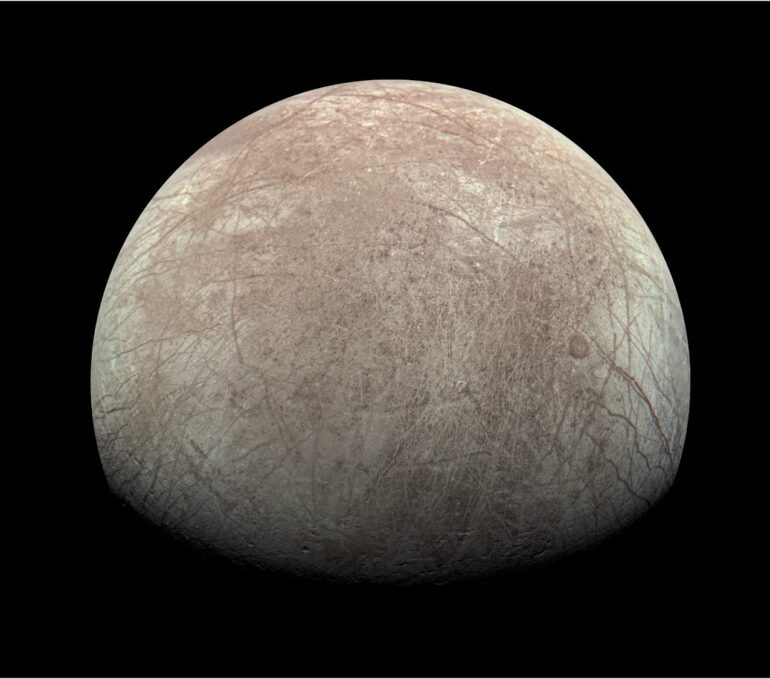Research reveals a new explanation for how the icy shell of Jupiter’s moon Europa rotates at a different rate than its interior. NASA’s Europa Clipper will take a closer look.
NASA scientists have strong evidence that Jupiter’s moon Europa has an internal ocean under its icy outer shell—an enormous body of salty water swirling around the moon’s rocky interior. New computer modeling suggests the water may actually be pushing the ice shell along, possibly speeding up and slowing down the rotation of the moon’s icy shell over time.
Scientists have known that Europa’s shell is probably free-floating, rotating at a different rate than the ocean below and the rocky interior. The new modeling is the first to show that Europa’s ocean currents could be contributing to the rotation of its icy shell.
A key element of the study involved calculating drag—the horizontal force that the moon’s ocean exerts on the ice above it. The research hints at how the power of the ocean flow and its drag against the ice layer could even account for some of the geology seen on Europa’s surface. Cracks and ridges could result from the icy shell slowly stretching and collapsing over time as it is pushed and tugged by the ocean currents.
“Before this, it was known through laboratory experiments and modeling that heating and cooling of Europa’s ocean may drive currents,” said Hamish Hay, a researcher at the University of Oxford and lead author of the study published in the Journal of Geophysical Research: Planets. Hay performed the research while a postdoctoral research associate at NASA’s Jet Propulsion Laboratory in Southern California. “Now our results highlight a coupling between the ocean and the rotation of the icy shell that was never previously considered.”
It might even be possible, using measurements gathered by NASA’s upcoming Europa Clipper mission, to determine with precision how fast the icy shell rotates. When scientists compare images gathered by Europa Clipper with those captured in the past by NASA’s Galileo and Voyager missions, they will be able to examine locations of ice surface features and potentially determine if the position of the moon’s icy shell has changed over time.
For decades, planetary scientists have debated whether Europa’s icy shell might be rotating faster than the deep interior. But rather than tying it to the ocean’s movement, scientists focused on an outside force: Jupiter. They theorized that as the gas giant’s gravity pulls on Europa, it also tugs on the moon’s shell and causes it to spin slightly faster.
“To me, it was completely unexpected that what happens in the ocean’s circulation could be enough to affect the icy shell. That was a huge surprise,” said co-author and Europa Clipper Project Scientist Robert Pappalardo of JPL. “And the idea that the cracks and ridges we see on Europa’s surface could be tied to the circulation of the ocean below—geologists don’t usually think, ‘Maybe it’s the ocean doing that.'”
Europa Clipper, now in its assembly, test, and launch operations phase at JPL, is set to launch in 2024. The spacecraft will begin orbiting Jupiter in 2030, and will use its suite of sophisticated instruments to gather science data as it flies by the moon about 50 times. The mission aims to determine if Europa, with its deep internal ocean, has conditions that could be suitable for life.
Like a pot of water
Using techniques developed to study Earth’s ocean, the paper’s authors relied on NASA supercomputers to make large-scale models of Europa’s ocean. They explored the complexities of how the water circulates, and how heating and cooling affects that movement.
Scientists believe that Europa’s internal ocean is heated from below, due to radioactive decay and tidal heating within the moon’s rocky core. Like water heating in a pot on a stove, Europa’s warm water rises to the top of the ocean.
In the simulations, the circulation initially moved vertically, but the rotation of the moon as a whole caused the flowing water to veer in a more horizontal direction—in east-west and west-east currents. The researchers, by including drag in their simulations, were able to determine that if the currents are fast enough, there could be adequate drag on the ice above to speed up or slow down the shell’s rotation speed. The amount of interior heating—and thus, circulation patterns in the ocean—may change over time, potentially speeding up or slowing rotation of the icy shell above.
“The work could be important in understanding how other ocean worlds’ rotation speeds may have changed over time,” Hay said. “And now that we know about the potential coupling of interior oceans with the surfaces of these bodies, we may learn more about their geological histories as well as Europa’s.”
Europa Clipper’s main science goal is to determine whether there are places below the surface of Jupiter’s icy moon, Europa, that could support life. The mission’s three main science objectives are to understand the nature of the ice shell and the ocean beneath it, along with their composition and geology. The mission’s detailed exploration of Europa will help scientists better understand the astrobiological potential for habitable worlds beyond our planet.
More information:
H. C. F. C. Hay et al, Turbulent Drag at the Ice‐Ocean Interface of Europa in Simulations of Rotating Convection: Implications for Nonsynchronous Rotation of the Ice Shell, Journal of Geophysical Research: Planets (2023). DOI: 10.1029/2022JE007648
Provided by
Jet Propulsion Laboratory
Citation:
Study finds ocean currents may affect rotation of Europa’s icy crust (2023, March 14)



